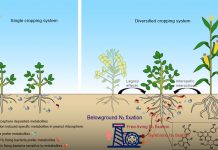Yao YL, Zhang M, Tian YH, Zhao M, Zeng K, Zhang BW, Zhao M, Yin B. Azolla biofertilizer for improving low nitrogen use efficiency in an intensive rice cropping system. Field Crops Research, 2018, 216: 158-164
Abstract
The efficient use of nitrogen (N) in crop production is critical for meeting the challenges of food security and environmental integrity. Azolla biofertilizer may be a promising approach to achieve better N use efficiency (NUE) in paddy rice fields due to its great potential for biological N fixation (BNF). The objective of this study was to determine the efficacy of partially substituting Azolla biofertilizer for synthetic N fertilizer to improve NUE, reduce N loss and enhance rice yield in the currently highly fertilized rice cropping systems of China. Therefore, a 3-year field experiment was conducted with five treatments: CK (control without urea), FN (farmers’ N practice), FNA (the farmers’ N combined with Azolla biofertilizer), RN (reducing farmers’ N by 25%) and RNA (substituting Azolla biofertilizer for 25% farmers’ N). The NUE, ammonia (NH3) volatilization, rice yield and net economic benefit (the difference between the value of the harvest grain and the costs of fertilizer and Azolla inputs) were assessed. The results showed that in the RNA and FNA treatments, Azolla biofertilizer produced higher recovery efficiency of fertilizer N by 69% and 59%, provided higher agronomic N use efficiency by 52% and 31% and achieved higher partial factor productivity of applied N by 43% and 13% than FN for the 3 years, respectively. In addition, the RNA and FNA treatments achieved crop 15N recovery that was 64% and 49% higher than the FN treatment, respectively. The improved NUE under the Azolla biofertilizer treatments were attributed to reduced N loss and enhanced N uptake by rice plants. The RNA and FNA treatments significantly reduced 15N loss by 48% and 26%, as well as lowered NH3 loss by 42% and 12% over FN, respectively. In addition, Azolla could fix 52 and 44 kg N ha−1 crop−1 in the RNA and FNA treatments, and thereby, Azolla biofertilizer resulted in higher N uptake that was 17% and 33% higher in the RNA and FNA groups than in FN, respectively. As a result, the RNA and FNA treatments achieved higher rice yield by 8% and 14% over FN, respectively, but they attained similar and higher net economic benefit over FN for the 3 years. Therefore, substituting Azolla biofertilizer for 25% of urea-N provides a financially attractive option for farmers to substantially improve NUE and yield and effectively reduce N loss in intensive rice cropping systems.








